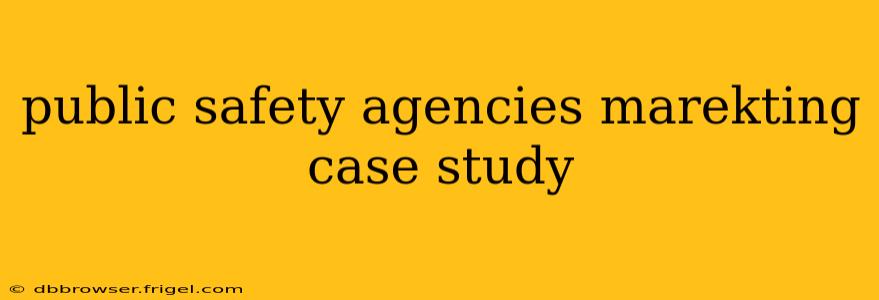Public safety agencies face a unique challenge: marketing life-saving information without resorting to fear-mongering or appearing alarmist. Their marketing efforts must build trust, foster community engagement, and ultimately, improve public safety. This case study explores successful marketing strategies employed by various public safety agencies, highlighting key learnings and best practices.
Why Marketing Matters for Public Safety
Effective marketing isn't just about promoting services; it's about fostering a culture of safety and preparedness. For public safety agencies, this translates to:
- Increased Public Awareness: Educating citizens about risks, prevention strategies, and emergency procedures.
- Improved Community Relations: Building trust and fostering collaborative relationships between the agency and the community it serves.
- Enhanced Response Efficiency: Equipping the public with the knowledge to act appropriately during emergencies, reducing response time and improving outcomes.
- Recruitment and Retention: Attracting and retaining qualified personnel through compelling employer branding.
Case Study Examples: Diverse Approaches, Shared Success
While each public safety agency's context is unique, several common threads weave through successful marketing campaigns:
1. Leveraging Social Media for Real-Time Communication
Many agencies utilize social media platforms like Facebook, Twitter, and Instagram for disseminating crucial information, sharing safety tips, and engaging with the community directly. This allows for real-time updates during emergencies and fosters a sense of immediacy and accessibility. Successful examples often involve:
- Targeted Advertising: Reaching specific demographics with tailored messages.
- Interactive Content: Polls, quizzes, and Q&A sessions to enhance engagement.
- Behind-the-Scenes Content: Humanizing the agency and showcasing the dedication of its personnel.
Example: A fire department using Instagram to share photos and videos of fire safety demonstrations, followed by engaging captions with prevention tips.
2. Community Engagement Programs: Building Trust Through Interaction
Direct community engagement is critical for building relationships and fostering a culture of safety. Examples include:
- Neighborhood Watch Programs: Empowering citizens to actively participate in crime prevention.
- Public Forums and Workshops: Providing opportunities for direct dialogue and addressing community concerns.
- School Outreach Programs: Educating children on safety procedures and building positive relationships with law enforcement.
Example: A police department hosting a community barbecue, providing an informal setting to interact with residents and address their concerns.
3. Targeted Campaigns Based on Data-Driven Insights
Effective public safety marketing relies on understanding the community's needs and concerns. Data analysis can identify specific risks, vulnerable populations, and communication preferences, allowing agencies to tailor their campaigns accordingly.
- Crime Mapping & Analysis: Identifying crime hotspots and tailoring prevention strategies.
- Demographic Analysis: Understanding the specific needs and communication preferences of diverse populations.
- Campaign Evaluation: Measuring the effectiveness of marketing initiatives to optimize future efforts.
Example: A health department using data to identify areas with high rates of opioid overdose and launching a targeted campaign focused on prevention and harm reduction.
4. Utilizing Multi-Channel Marketing for Wider Reach
Reaching diverse audiences requires a multi-channel approach that incorporates various communication methods:
- Traditional Media: News releases, public service announcements (PSAs), and partnerships with local media outlets.
- Digital Media: Website, social media, email marketing, and online advertising.
- Community Partnerships: Collaborating with local businesses, schools, and community organizations to expand reach.
Example: A coastal city's emergency management agency using radio PSAs during hurricane season, coupled with website updates and social media alerts.
Addressing Common Challenges
Public safety agencies often face unique marketing challenges:
How do you market safety without causing undue alarm?
Focus on empowerment and preparedness, emphasizing proactive steps individuals can take to improve their safety. Frame messages positively, focusing on solutions and prevention rather than fear.
How do you build trust with a community that may have negative perceptions of law enforcement?
Transparency, accountability, and consistent community engagement are key. Showcasing positive interactions, highlighting success stories, and actively soliciting feedback are crucial.
What metrics should be used to measure the success of public safety marketing campaigns?
Measure changes in awareness, engagement, participation in prevention programs, and ultimately, reductions in incidents related to the targeted risk.
Conclusion
Effective marketing is essential for public safety agencies. By adopting a data-driven, multi-channel approach that prioritizes community engagement and trust-building, agencies can significantly improve public safety and foster a more secure and resilient community. The examples provided illustrate the diverse strategies that can be employed, highlighting the importance of adaptation and ongoing evaluation to maximize impact.
